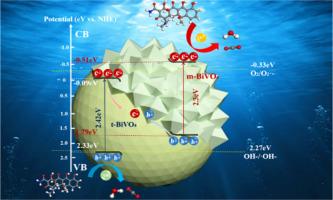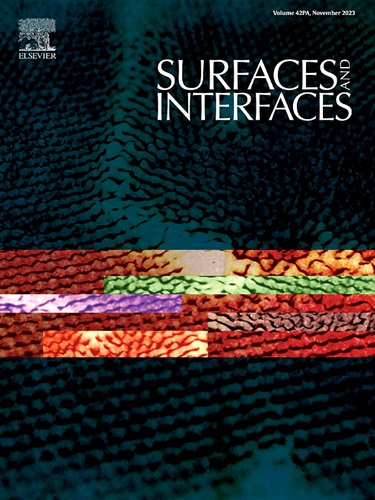通过巨型内置电场增强 Z 型 BiVO4 异相结的光催化活性
IF 5.7
2区 材料科学
Q2 CHEMISTRY, PHYSICAL
引用次数: 0
摘要
内置电场(IEF)可促进电荷分离和转移,从而提高光催化效率。本文成功构建了具有巨型内电场的 Z 型 BiVO4 异相结。通过改变前驱体溶液的pH值,调节单斜八面体BiVO4(m-BVO)与四方微球BiVO4(t-BVO)的比例,形成异相结(mt-BVO),从而调节IEF强度。当 pH = 0.5 时,mt-BVO-35%m 在两种形态的界面上形成大量孔隙,因此具有更大的比表面积。在可见光照射下,其反应速率常数 k 是纯 m-BVO 的 3 倍,TOC 去除率从 12% 提高到 36%。通过表征可以证明,mt-BVO-35%m 的 IEF 强度是 m-BVO 的 11.86 倍。活性的大幅提高主要归功于 mt-BVO 和 t-BVO 之间存在巨大的 IEF。IEF 驱使光生电子从 t-BiVO4 的 CB 转移到 m-BiVO4 的 VB,从而大大提高了光生电荷载流子的分离和转移。此外,还揭示了 mt-BVO-35%m 异相结中 Z 型电荷转移途径的机制。本文章由计算机程序翻译,如有差异,请以英文原文为准。

Enhanced photocatalytic activity of Z-scheme BiVO4 heterophase junction via giant built-in electric field
Built-in electric field (IEF) can improve photocatalytic efficiency by promoting charge separation and transfer. Herein, a Z-scheme BiVO4 heterophase junction with giant IEF was successfully constructed. By changing the pH value of the precursor solution, the ratio of monoclinic octahedral BiVO4 (m-BVO) to tetragonal microsphere BiVO4 (t-BVO) is regulated to form a heterophase junction (mt-BVO), so as to regulate the IEF intensity. When pH = 0.5, a large number of pores were formed at the interface of the two forms in mt-BVO-35%m, so it has a larger specific surface area. mt-BVO-35%m has optimal photocatalytic tetracycline degradation activity. Under visible light irradiation, its reaction rate constant k is shown to be 3 times higher than that of pure m-BVO, and the TOC removal rate has increased from 12 % to 36 %. Through characterization, it can be proved that the IEF strength of mt-BVO-35%m is 11.86 times that of m-BVO. The significantly improved activity is mainly attributed to the presence of a giant IEF between m-BVO and t-BVO. The IEF drives the photogenerated electrons to transfer from the CB of t-BiVO4 to the VB of m-BiVO4, which greatly enhances the separation and transfer of photogenerated charge carriers. Moreover, a mechanism of Z-scheme charges transfer pathway in the mt-BVO-35%m heterophase junction was also revealed.
求助全文
通过发布文献求助,成功后即可免费获取论文全文。
去求助
来源期刊

Surfaces and Interfaces
Chemistry-General Chemistry
CiteScore
8.50
自引率
6.50%
发文量
753
审稿时长
35 days
期刊介绍:
The aim of the journal is to provide a respectful outlet for ''sound science'' papers in all research areas on surfaces and interfaces. We define sound science papers as papers that describe new and well-executed research, but that do not necessarily provide brand new insights or are merely a description of research results.
Surfaces and Interfaces publishes research papers in all fields of surface science which may not always find the right home on first submission to our Elsevier sister journals (Applied Surface, Surface and Coatings Technology, Thin Solid Films)
 求助内容:
求助内容: 应助结果提醒方式:
应助结果提醒方式:


